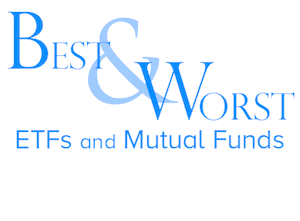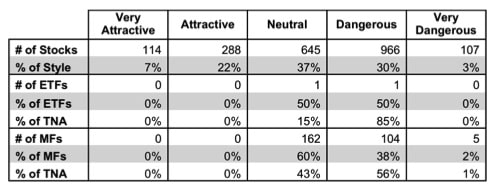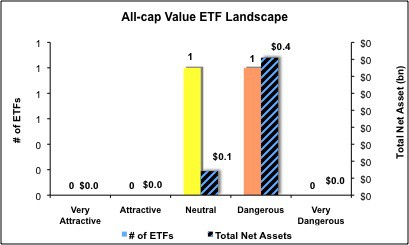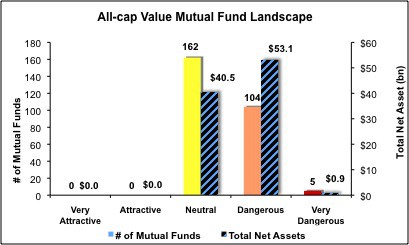The All-cap Value style ranks sixth out of the twelve fund styles as detailed in my Style Rankings for ETFs and Mutual Funds report. It gets my Neutral rating, which is based on aggregation of ratings of 2 ETFs and 271 mutual funds in the All-cap Value style as of May 2, 2013. Prior reports on the best & worst ETFs and mutual funds in every sector and style are here.
Figure 1 ranks from best to worst the two All-cap Value ETFs and Figure 2 shows the five best and worst-rated All-cap Value mutual funds. Not all All-cap Value style ETFs and mutual funds are created the same. The number of holdings varies widely (from 12 to 2020), which creates drastically different investment implications and ratings. The best ETFs and mutual funds allocate more value to Attractive-or-better-rated stocks than the worst, which allocate too much value to Neutral-or-worse-rated stocks.
To identify the best and avoid the worst ETFs and mutual funds within the All-cap Value style, investors need a predictive rating based on (1) stocks ratings of the holdings and (2) the all-in expenses of each ETF and mutual fund. Investors need not rely on backward-looking ratings.
My fund rating methodology is detailed here.
Investors should not buy any All-cap Value ETFs or mutual funds because none get an Attractive-or-better rating. If you must have exposure to this style, you should buy a basket of Attractive-or-better rated stocks and avoid paying undeserved fund fees. Active management has a long history of not paying off.
Get my ratings on all ETFs and mutual funds in this style on my free mutual fund and ETF screener.
Figure 1: ETFs with the Best & Worst Ratings
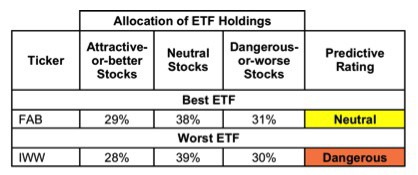
Sources: New Constructs, LLC and company filings
Figure 2: Mutual Funds with the Best & Worst Ratings – Top 5
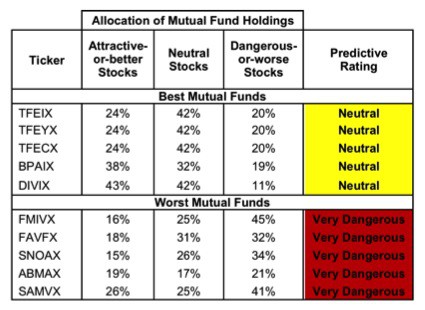
Sources: New Constructs, LLC and company filings
Williamsburg Investment Trust: FBP Equity & Dividend Plus Fund (FBPEX) and AQR US Defensive Equity Fund (AUEIX) are excluded from Figure 2 because their total net assets (TNA) are below $100 million and do not meet our liquidity standards.
First Trust Multi Cap Value AlphaDEX Fund (FAB) is my top-rated All-cap Value ETF and Touchstone Focused Equity Fund (TFEIX) is my top-rated All-cap Value mutual fund. Both earn my Neutral rating. For those investors that cannot afford the $500,000 initial minimum of TFEIX, TFEYX offers the same holdings for just slightly higher costs and a much lower initial minimum.
iShares Russell 3000 Value (IWW) is my worst-rated All-cap Value ETF and RidgeWorth Funds: Mid-Cap Value Equity Fund (SAMVX) is my worst-rated All-cap Value mutual fund. Note the discrepancy between the name of the fund and the true nature of its holdings. You cannot trust mutual fund labels. IWW earns my Dangerous rating and SAMVX earns my Very Dangerous rating.
Figure 3 shows that 402 out of the 2,120 stocks (over 29% of the market value) in All-cap Value ETFs and mutual funds get an Attractive-or-better rating. However, no ETFs or mutual funds in the All-cap Value style get an Attractive-or-better rating.
I am astonished that no ETFs or mutual funds allocate enough to the Attractive stocks in this style given that those stocks make up 29% of the market value of all stocks in the style.
The takeaways are: mutual fund managers allocate too much capital to low-quality stocks and All-cap Value ETFs hold poor quality stocks.
Figure 3: All-cap Value Style Landscape For ETFs, Mutual Funds & Stocks
As detailed in “Cheap Funds Dupe Investors”, the fund industry offers many cheap funds but very few funds with high-quality stocks, or with what I call good portfolio management.
Investors need to tread carefully when considering All-cap Value ETFs and mutual funds, as one ETF (85% of total net assets) and 109 mutual funds (57% of total net assets) in the All-cap Value style earn a Dangerous-or-worse rating. No All-cap Value ETFs or mutual funds allocate enough value to Attractive-or-better rated stocks to earn an Attractive rating. Investors should focus on individual stocks instead.
Amgen, Inc. (AMGN) is one of my favorite stocks held by All-cap Value ETFs and mutual funds and earns my Very Attractive rating. I really like AMGN’s track record of growth. Over the past 14 years it has grown after tax profit (NOPAT) by 15% compounded annually. That kind of long-term growth, as well as AMGN’s consistently high return on invested capital (ROIC), speaks to an ability to continually innovate and develop new and useful therapeutics. The company is well positioned to continue leading the way in biotechnology, with nearly $24 billion in excess cash on hand to fund research and investment. Fortunately for investors, this high performing company is available at a cheap price right now. At its current valuation of ~$104.54/share, AMGN has a price to economic book value ratio of only 0.9, implying that its NOPAT will permanently decline by 10%. Given AMGN’s track record, it is hard to imagine that it will see its business shrink that severely. Low expectations combined with high performance combine to make AMGN a great stock for investors.
International Paper Company (IP) is one of my least favorite stocks held by All-cap Value ETFs and mutual funds and earns my Dangerous rating. The world is steadily going paperless, and IP’s other divisions—like industrial packaging—are not doing enough to offset the decline in its printing paper business. Evidence of IP’s long-term decline can be seen in its declining NOPAT, which was 18% less in 2012 than in 2000. IP’s low NOPAT gives it a bottom-quintile ROIC of only 4%. The declining profitability of the paper industry is not exactly a secret, so it’s surprising that IP is priced like a company poised for major growth. At its current valuation of ~$45.89/share, IP has a very high price to economic book value ratio of 4.3. To justify this high valuation, IP would need to grow NOPAT by 10% compounded annually for 16 years. I cannot picture a scenario where that kind of growth is realistic for IP.
Figures 4 and 5 show the rating landscape of all All-cap Value ETFs and mutual funds.
My Style Rankings for ETFs and Mutual Funds report ranks all styles and highlights those that offer the best investments.
Figure 4: Separating the Best ETFs From the Worst Funds
Figure 5: Separating the Best Mutual Funds From the Worst Funds
Review my full list of ratings and rankings along with reports on all 2 ETFs and 271 mutual funds in the All-cap Value style.
Disclosure: David Trainer and Sam McBride receive no compensation to write about any specific stock, sector, style or theme.
